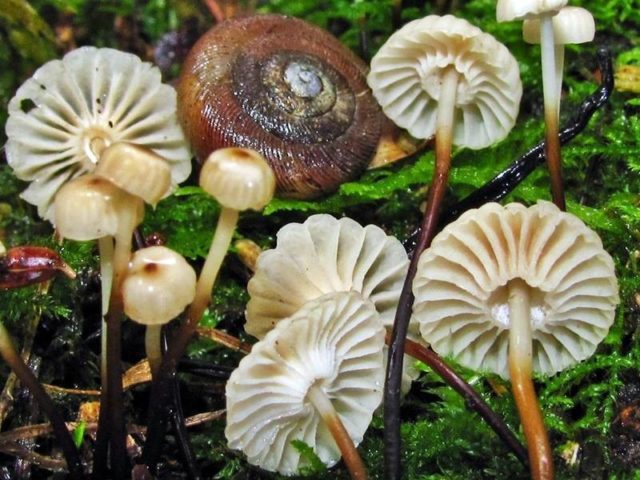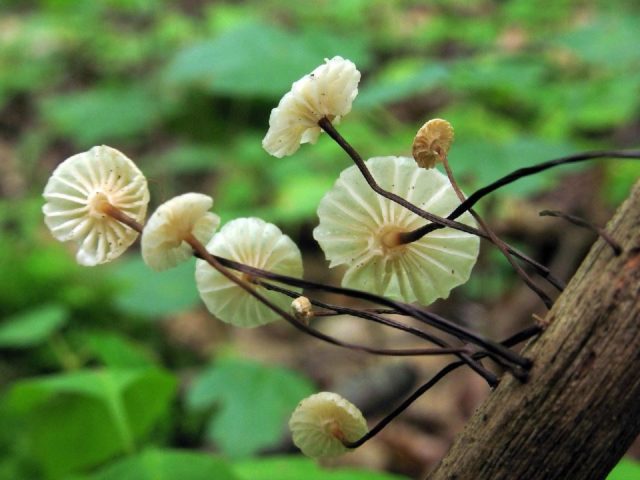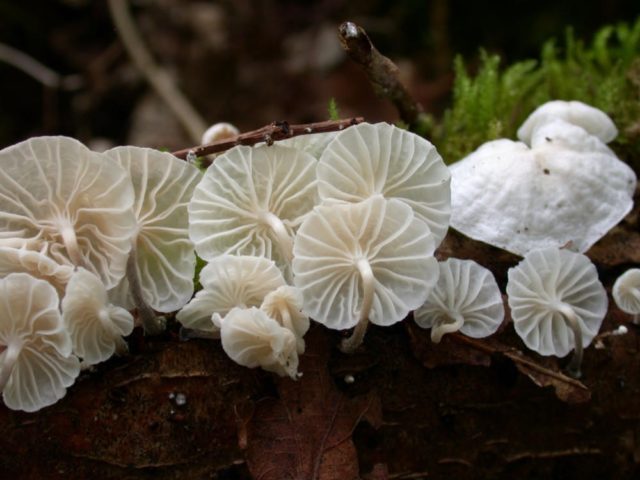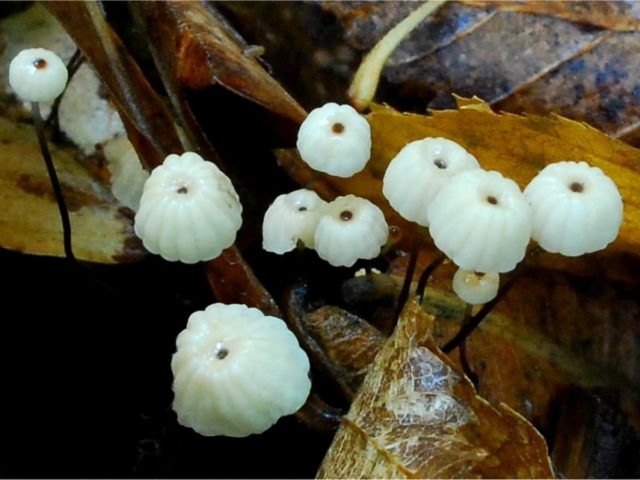Content
Wheeled Negniychnik (Marasmius rotula) is a miniature fruit body from the Negniychnikov family and the Negniychnik family. It was first described and classified by the Italian-Austrian naturalist Giovanni Scopoli in 1772 as a wheel mushroom. Its other names:
- collar merulius, from 1796, W. Withering;
- micromphale collar, since 1821, S. Gray;
- stamen wheel-shaped, since 1887, N. Patuillard;
- chameceras wheel-shaped, since 1898, O. Kunze.
What does a wheel-shaped non-iron pot look like?
Fruit bodies are small even in adulthood. The legs are thin and, compared to the caps, are significantly elongated, threadlike.

The spiderweed is wheel-shaped around the circumference of the cap rarely exceeds the size of an ordinary snail
Description of the hat
In new mushrooms, the caps look like a rounded-ribbed screw head. The middle is straight or with a small funnel-shaped depression, with a dark reddish-brown tubercle. From half the diameter, the surface is lowered down almost at a right angle, in some cases the edges are slightly tucked towards the stem. As it develops, the wheel-shaped non-nippon spreads the cap, which becomes first domed, then umbrella-shaped, and then spread out, often with the edges lowered down. The narrow funnel in the place of growth to the peduncle remains and deepens. The diameter varies from 0.3 to 1.4 cm.
The surface is muco-moist, smooth. Longitudinally wavy or even, tuberous in overgrowths. Snow white or creamy yellowish in color, with a dark center. Sometimes with brown spots, when dry it becomes sandy brown or light ocher. The edge is sinuous-toothed, segmental, often wavy. The pulp is thin, fragile, with an unpleasant odor.
The plates of the hymenophore are rare, sometimes sinuous, the cap from the inside is very reminiscent of the petals of a flower or an umbrella attached to a collarium collar. The color is similar to the color of the cap. Spore powder is white.

The radial plates of the hymenophore are clearly visible through the parchment-thin pulp
Leg description
The wheeler-shaped nematode has a long leg. Thin, no more than 1.8 mm, smooth, hollow inside. Often curved, from 2 to 9 cm long. The color is uneven, in young mushrooms the color is lighter. Dark at the root: resinous amber, brown, golden to chocolate and charcoal black, and silvery white or cream at the cap. Drying, the leg becomes wrinkled, longitudinally folded.

Dried legs take on the appearance of a charred match
Where and how it grows
The wheeze grows on decaying wood, thick forest floor, in dead woods and on old rotten stumps. Loves wet places. Prefers deciduous or mixed forests. It is found often and everywhere, it is a cosmopolitan mushroom.Distribution area - Europe, Asia, North America. In Russia, it is most common in Siberia and the northern Caucasus.
It grows in large colonies, forming amazingly beautiful white-star-shaped blotches against the background of brown forest litter. The fruiting period of the mycelium is from July to October.

Favorite habitat - fallen, wet tree trunks
Is the mushroom edible or not
Wheeled non-fungus is classified as an inedible mushroom due to its unpleasant odor and low nutritional value. There are no data on its toxicity.
Doubles and their differences
The wheeler-shaped snake can be confused with other representatives of its species.
Cheese honey fungus (Marasmius bulliardii). Inedible due to its diminutive size. The color and shape of the cap completely coincide, it is snow-white at first, with age it changes its color to ocher, cream or pinkish. The only noticeable difference is that the plates of the hymenophore are not attached to the collar on the leg, as in the nonnium wheel.

Amazingly beautiful mushrooms that are difficult to spot
Conclusion
Negniychnik wheel-shaped is an exquisitely fragile miniature mushroom from the genus Negniychnikov. It inhabits deciduous and coniferous waste, pieces of semi-rotten bark, rotting stumps and tree trunks. Loves places saturated with moisture, gullies, lowlands. Found in deciduous and mixed forests, throughout the Northern Hemisphere. In Russia, it can be especially often seen in the Caucasus and in the taiga forests. Inedible, the pulp has a pungent unpleasant odor. There is no data on its toxicity. Used in laboratories as an identifier for certain substances. Has inedible counterparts belonging to his species.








